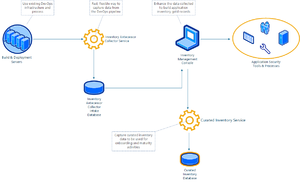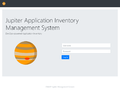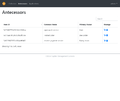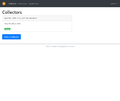This site is the archived OWASP Foundation Wiki and is no longer accepting Account Requests.
To view the new OWASP Foundation website, please visit https://owasp.org
OWASP Jupiter
From OWASP
Jupiter Application Inventory Management System Roadmap
- Collector Service
- Authentication
- Utilize Auth Service for JWT validation
- Authorization
- Based on JWT payload, enforce restrictions on CRUD operations
- Database Connectivity
- Update Mongo connection code to update deprecated connection method
- Input Validation
- Input length checks
- Input type checks
- Data Fields
- Enable data fields beyond Common Name and Primary Owner
- Containerization
- Prepare Dockerfile
- Build Docker container
- Deploy and test Docker container
- Authentication
- Curated Inventory Service
- Authentication
- Utilize Auth Service for JWT validation
- Authorization
- Based on JWT payload, enforce restrictions on CRUD operations
- Input Validation
- Input length checks
- Input type checks
- Data Fields
- Enable Application-specific data fields beyond Common Name and Primary Owner
- Enable capture of Collector Service instance ID
- Data Integrity
- Restrict Common Name to unique values
- Containerization
- Prepare Dockerfile
- Build Docker container
- Deploy and test Docker container
- Authentication
- Auth Service
- Authentication
- Enable LDAP authentication
- Build LDAP integration capabilities
- Based on successful username/password LDAP authentication, provide time-limited JSON Web Token for subsequent requests
- Enable facility to validate expiration of tokens and deny access to expired tokens
- Enable LDAP authentication
- Authentication
- Define user roles (administrator, reader, creator/updater)
- Enable issuance of tokens that restrict access based on user role
- Authentication
- Management Console
- Base Architecture
- Add Local SQLite Database
- Enable saving of configuration and preferences
- Add Local SQLite Database
- Authentication
- Collector Services
- Build an interface to allow configuration of Collector Services
- Curated Inventory Service
- Build an interface to allow configuration of Curated Inventory Service
- Collector Services
- Data Fields
- Enable Application-specific data fields beyond Common Name and Primary Owner
- External Integrations
- Consistent naming across multiple external Application Security tools will allow for greater future automation and reporting as well as utilization.
- Enable set up of Application in Fortify Software Security Center
- Enable set up of Application in OWASP Dependency-Track
- Enable set up of Application in OWASP Defect Dojo
- Enable set up of Application in OWASP SecurityRAT
- User Experience
- Antecessors
- Aggregate all Collectors’ data in available Antecessors list when there is more than one Collector Service defined
- Antecessors
- Base Architecture
- Jenkins Collector Plugin
- Input Validation
- Input length checks
- Input type checks
- Connectivity Validation
- Add a “Test Connection…” button to the Global config screen to test the Collector URL and token
- Data Fields
- Enable Application-specific data fields beyond Common Name and Primary Owner under “Advanced”
- Input Validation
FAQ
Q: Why is this project named "Jupiter"?
A: In 2001: A Space Odyssey, the Discovery One embarked on a mission to investigate the signal sent from the monolith on the Moon to Jupiter. In 2010: The Year We Make Contact, the crews of the Discovery and Leonov witness countless monoliths emerge from Jupiter before it is converted into a star. Aside from the cool sci-fi reference, there is an analog to what this project is for -- to start with a small amount of information about software applications in an organization's portfolio and build upon that knowledge to find more.







